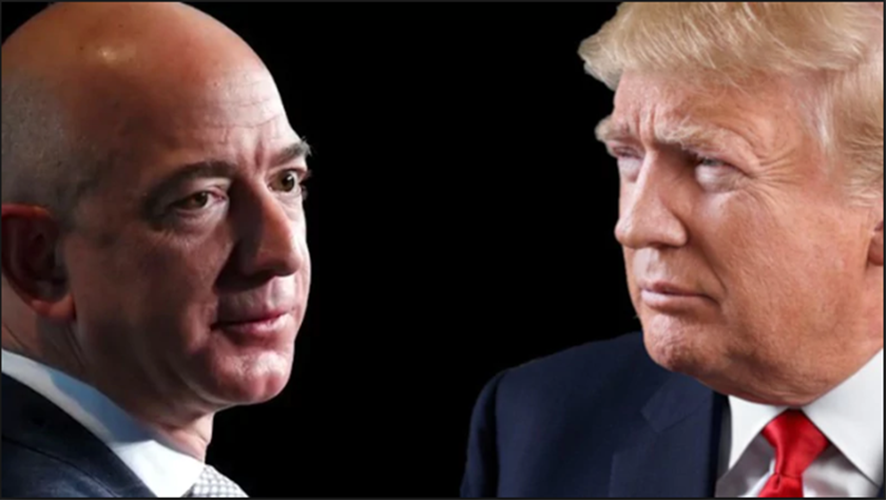
President Trump’s slam of Amazon in a March 29 tweet is hardly the first time the two have clashed.
The U.S. Postal Service says that its large financial losses are caused by market forces and governmental constraints but not Amazon.com, in a release of its quarterly statistics that stood in contrast to pointed statements made by President Trump.

Trump made waves in March when he declared that the Postal Service was losing money on every package it delivered for Amazon and falsely asserted that The Washington Post was a lobbyist for the company, before ordering a review of the service’s finances.

The Post is owned by Jeffrey P. Bezos, who is the founder and chief executive of Amazon, but the two firms are independent of each other.
But the Postal Service’s second-quarter results, which were released Friday, note that increases in shipping and package volume remained areas of strong revenue growth amid other declines and economic pressures, which added up to a $1.3 billion net loss in the quarter.
Though mail was down by 700 million pieces or 2.1 percent, package volume grew by some 70 million pieces, about 5 percent, the report said.
While revenue overall had grown slightly to $17.5 billion, due in part to these increases, operating costs had surged up 5.7 percent, driven by rising costs connected to retiree health benefits, employee compensation and transportation expenses from increased fuel rates and contractual issues.
Officials also cited declining letter volumes, and in particular the decline of the use of First Class and marketing mail, as a challenge faced by the business.
“Despite growth in our package business, our financial results reflect systemic trends in the marketplace and the effects of an inflexible, legislatively mandated business model that limits our ability to generate sufficient revenue and imposes costs upon us that we cannot afford,” Postmaster General Megan J. Brennan said in a statement. “With continued aggressive management and greater legal authority to respond to changes in our marketplace and to control our costs, the Postal Service can return to financial sustainability.”
The Postal Service has petitioned the Postal Regulatory Commission, the independent body that regulates it, to give it the ability to raise stamp prices beyond inflation, according to the Associated Press.
“Congress and the commission need to act now,” Brennan said.
The Postal Service did note that the “labor-intensive” package business had raised employee-compensation expenses by $364 million.
Amazon uses the Postal Service for about 40 percent of its shipping needs, analysts have estimated, with a per-package cost of about $2, which is significantly lower than the rates charged by other major shippers, according to Post business writer Steve Pearlstein. Amazon shipped more than 1.2 billion packages in the United States last year, according to statistics cited by the Wall Street Journal.
The agency’s regulator has disputed the idea that Amazon is hurting its business. The Wall Street Journal reported that former postmaster general Patrick Donahoe told analysts last week that the contract with Amazon had been profitable for the Postal Service.
Pearlstein, who acknowledged the complex economic issues at play in the contract, wrote that the arrangement is likely a win for both Amazon and the Postal Service, which is getting additional business for something it is already set up to do: stop at every home, business, and rural post box six days a week, though it now provides the service on Sundays for Amazon.
[Is the post office making or losing money delivering Amazon packages?]
“Looked at from the standpoint of incremental revenue (huge) minus these incremental expenses (modest), the Postal Service could very easily have come to the conclusion that, even at $2 a package, the Amazon contract was likely to be highly profitable,” Pearlstein wrote.
Ultimately, the complexities of the Postal Service’s modern financial picture is “a reality that is way too complicated for our president to understand,” he wrote.
On Friday, Postal Service Chief Financial Officer Joseph Corbett pointed to the “decline in First Class mail, rising costs and legislative and regulatory constraints,” for the quarter’s losses.
Trump’s executive order for a review of Postal Services finances requires it to identify potential changes so it can operate under a “sustainable business model.” The order does not single out Amazon by name and notes economic pressures similar to the ones cited Friday by Postal Service officials: declining volume of First Class mail, legal mandates that give it inflexible costs and challenges balancing its books in the face of its pension liabilities and retiree health obligations.
- This story was first reported by Washington Post









